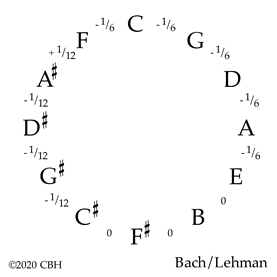Technical Library
TEMPERAMENTS XXIV: Bach/Lehman
Entire Contents Copyright © 2020 CBHTechnical LibraryTEMPERAMENTS XXIV: Bach/Lehman Entire Contents Copyright © 2020 CBH |

 Now, who is to say that the fifths around the circle which we temper must all
be the same size?
Now, who is to say that the fifths around the circle which we temper must all
be the same size?
A recent Bach temperament is attracting a lot of interest in continental Europe especially, where it is quite often being requested for concert use. Along with the interest, though, comes quite some controversy.
This temperament tweaks a number of the accidentals to produce something that removes considerable roughness from the remote keys, but only at the expense of dirtying up the near sharp keys. It retains considerable color, and seems just as, or more versatile, than Vallotti. E Major becomes one of the roughest sounding keys which is quite extraordinary, but f minor, which has been notoriously tricky (for example, in the Bach Violin Sonata) then is wonderfully easy for string players to place their notes.
 Recent research by Dr Bradley Lehman of Virginia, part 1 of which was published
in the February 2005 Early Music, under the title “Bach’s
extraordinary temperament: our Rosetta Stone” suggests that Bach did indeed
specify tuning instructions for a temperament intended for the Das wohltemperirte
Clavier by hiding them in what was thought for many years to be an ornamental
squiggle on the title page of his own copy.
Recent research by Dr Bradley Lehman of Virginia, part 1 of which was published
in the February 2005 Early Music, under the title “Bach’s
extraordinary temperament: our Rosetta Stone” suggests that Bach did indeed
specify tuning instructions for a temperament intended for the Das wohltemperirte
Clavier by hiding them in what was thought for many years to be an ornamental
squiggle on the title page of his own copy.
According to Dr Lehman, when turned upside down, the squiggle is an elegant but abstract representation of a chain of fifths running from F to A♯. (Bach denoted the position of C in the chain by the “C” attached to the top of “Clavier”.) The size of each fifth is denoted by the number of squiggles contained in each unit. Three fifths, e–b, b–f♯ and f♯–c♯are tuned pure: These are the plain circles in the chain.
 For
a full discussion of the background to this interesting temperament, along with
excellent tuning instructions to begin it from scratch, please refer to Dr Lehman’s
website.
For
a full discussion of the background to this interesting temperament, along with
excellent tuning instructions to begin it from scratch, please refer to Dr Lehman’s
website.
When we connect both ends of Bach’s inverted chain to make the circle of fifths that I’ve been using in these pages to help you visualize each temperament, you can see that all the naturals except B are in fact tuned identically to Vallotti. A moment’s examination of the circle will reveal the following: The three pure fifths beyond E serve to improve the extreme sharp keys, there are three slightly narrow fifths, and (Aghast!) there is one fifth larger than pure.
If you have just tuned Vallotti, follow these three steps to convert it to the Bach/Lehman temperament:
1. Retune your b a pure fifth above e, and continue the circle with another two pure tuned fifths, b–f♯' and f♯–c♯'.
2. You already have pure fifths remaining from Vallotti around the flat side of F, but you must retune your g♯ pure to c♯ and then slightly lower it so c♯–g♯ and g♯–d♯ are very slightly narrow with a barely perceptible beat.
3. Finally, lower your b♭ (a♯) slightly so that it makes the same sounding narrow fifth with the d♯ below it, as the interval c♯–g♯ a tone lower. This will make your slightly wide, slowly beating fifth with f'. (I’ve spelt all the accidentals as sharps in the circle for this temperament because Bach made the break in his chain in the same place, and we didn’t actually deliberately tune the a♯–f' “fifth”—really a sixth.)
Is this the real Bach temperament? I don’t know: There have been many contenders to fill this in the past—some of which we’ve discussed here, although not a recent effort extrapolating a temperament from the left hand ornaments contained within a prelude for W.F. Bach. Dr Lehman is as enthusiastic as the others. However, it remains that the squiggle occurs on only a single copy of the music, and you might find its cryptic nature is a little odd if Bach was hoping for wide dissemination and understanding of his Das wohltemperirte Clavier.
Try it, and see if it works for you.
Further discussion
Anonymous [Kayano, Moxzan] Dodecagon — Chi-s akt temo Tokyo 2012, p93 (“Lehmann [sic] 1722”)
Williams, Peter JS Bach — A Life in Music Cambridge 2007, pp333–338
| Pitch nomenclature | |
| Harpsichord Tuning Process | |
| Tuning Bibliography | |
| Technical Library overview | |
| Harpsichords Australia Home Page |